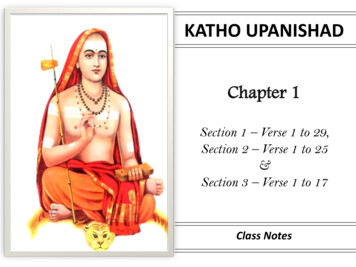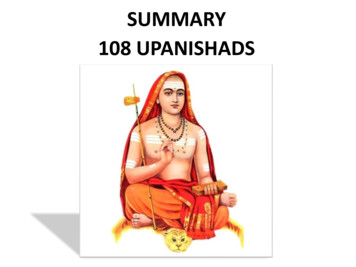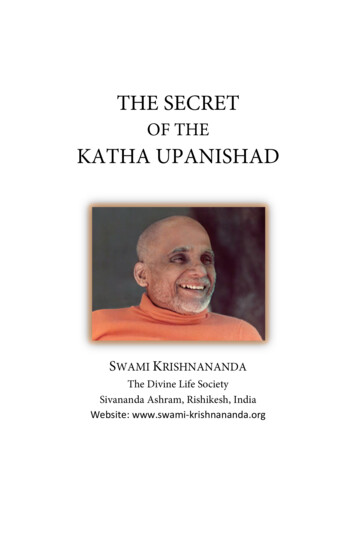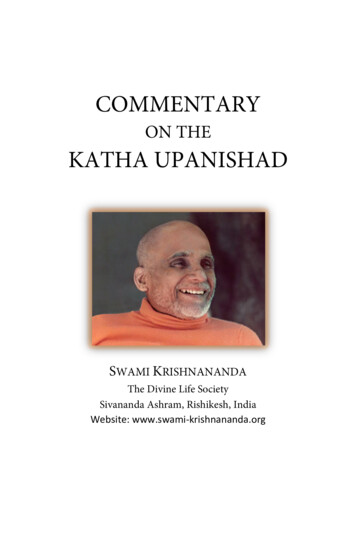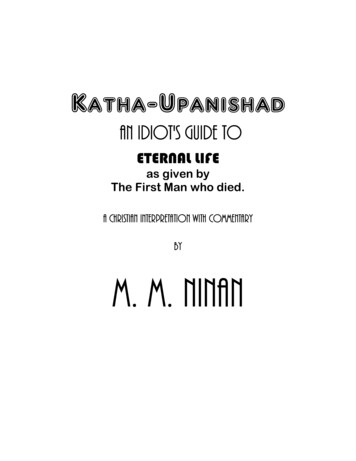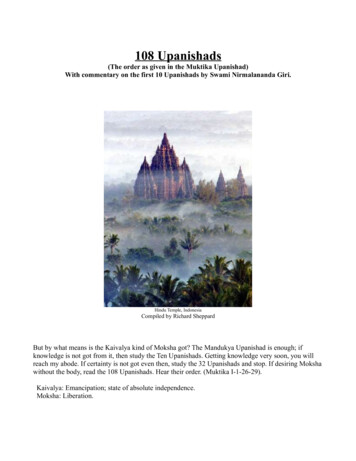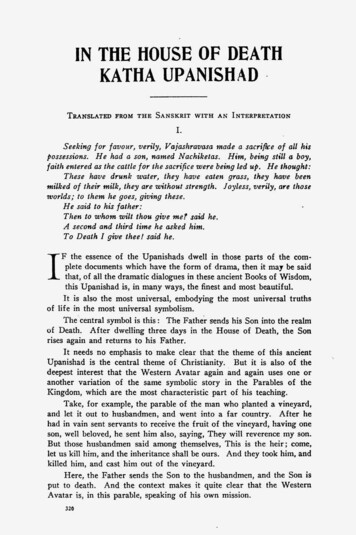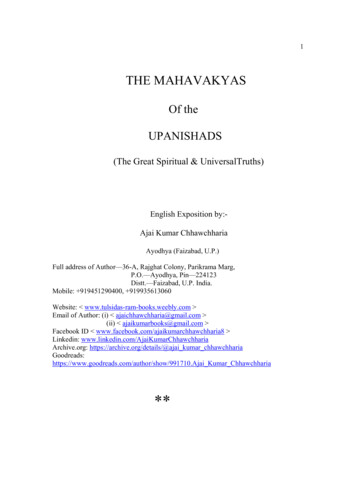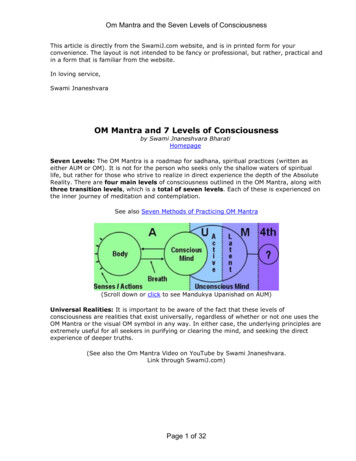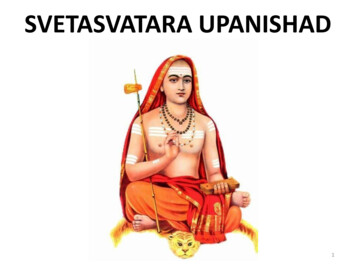
Transcription
SVETASVATARA UPANISHAD1
PRAYEROm poornamadah poornamidam IPoornaath poorna mudachyate IPoornasya poorna madaaya IPoorname vaava sishyate IOm shanti shanti shanti hi IIOm, That is Full, This also is Full,From Fullness comes that Fullness,Taking Fullness from Fullness,Fullness Indeed Remains.Om Peace, Peace, Peace.
INTRODUCTION : Krishna Yajur Veda Sage : SvetasvataraSage with Pure senses – without likes dislikesSveta – Pure, whiteAsva – Horse / Senses Student : Group of Rishis6 Chapters – 113 VersesChapter IChapter IIChapter IIIChapter IVChapter VChapter VI16 Verses17 Verses21 Verses22 Verses14 Verses23 VersesDeeperanalysis ofnature ofgod- Nature ofindividual, godand essentialoneness- Important toknow natureof god- Means ofrealisation- Importantto knowhow torealiseGod.MainTheme :RealiseonenessMeditation asmeans torealiseonenessPreliminaryanalysis –nature ofgodNote : Upanishad focuses more on the Nature of God.3
Summary of Chapters1)ThatThouArtOmniscient,Omnipotent GodFinite IndividualEssential oneness2) 1st Chapter Main theme to realise oneness 2nd Chapter Meditation as means to realise this oneness 3rd Chapter Tat – Pada shodanam – Nature of God. 4th Chapter Deeper Analysis of GodExplore full depth of the subject. 5th Chapter Nature of God / Individual / essential oneness. 6th Chapter Means of realisation.4
Introduction : Belongs to Krishna Yajur Veda, given by Svetasvatara Rishi, no Bashyam of Shankara. Not structured well developed teaching. Compilation from Mundak Upanishad, Katho Upanishad, Rudram, MahanarayanaUpanishad and Purusha Suktam. 23 Mantras taken from other parts of vedas. Total 113 verses, 6 chapters.4 TopicsIshvara SvarupamIshvara SvarupaJnanamIshvara SvarupaJnana SadhanamIshvara SvarupaJnana PhalamTopic 1 :Ishvara SvarupamSaguna- Vishwarupa IshvaraVarnanamNirguna- Jivatma / ParamatmaAikyam- Mahavakyam5
Topic 2 : Jnanam alone means liberation (24 Mantras).Topic 3 : Jnana Sadhanam – Mano Nigrahaha (Yoga technique in 2 chapter) Source for Patanjali yoga sutra.Topic 4 :Jnana PhalamJeevan MuktiVideha Mukti6
Summary113 VersesChapter 1Chapter 2Chapter 3Chapter 4Chapter 5Chapter 616 Verses17 Verses21 Verses22 Verses14 Verses23 VersesImportant :10, 11, 12,15, 16Important :5, 15Important :19Important :3, 5, 8, 9, 10Important :1, 9, 10Important :7, 8, 9, 11,18, 19, 20, 21Highlighted :12, 15, 16Highlighted :15Highlighted :19Highlighted :3, 10Highlighted :10Highlighted :11, 18, 217
CHAPTER 1Verse 1 :Students of Brahman (i.e. the Vedas) discuss (among themselves) : What is the cause? (is it) Brahman? whence are weborn? Why do we live? Where is our final rest? Under whose orders are we, who know the Brahman, subjected to thelaw of happiness and misery? [Chapter 1 – Verse 1]Disciples :1. Is Brahman the ultimate cause of the world.2. Where have we come from? (Did we exist before we came into our mothers womb)3. What gives life? Food, air, water?4. Where do we go after death?Body goes back to earth what about the life that sustains it? In what does creationmerge?5. What law governs Joy and sorrow?What is the power behind our action?8
Verse 2 :Time, nature, law, chance, matter, energy, intelligence - neither these, nor a combination of these, can bear examinationbecause of their own birth, identity and the existence of the self. The self also is not a free agent, being under the swayof happiness and misery. [Chapter 1 – Verse 2]Possible Causes of creation are :1. Kala – Time2. Svabhava – Nature3. Niyati – Actions giving fruit4. Yadrccha – Accidentality5. 5 Elements6. JivatmaAll above inert not sentient don’t have power to work independently. Jivatma –under destiny of Prarabda is cause of pain and pleasure. Therefore cause issomething else.9
Verse 3 :Practising the method of meditation, they realized that Being who is the God of religion, the Self of philosophy andthe Energy of science; who exists as the self-luminous power in everyone ; who is the source of the intellect, emotionsand will; who is one without a second; who presides over all the causes enumerated above, beginning with time andending with the individual soul; and who had been incomprehensible because of the limitations of their own intellect.[Chapter 1 – Verse 3] Maya of Lord with 3 Gunas – Satwa, Rajas, Tamas (Modes or qualities) is cause ofcreation.Verse 4 :We think of Him as the universe resembling a wheel which has one felly with a triple tyre, sixteen extremities, fiftyspokes, twenty counter-spokes and six sets of eight ; which is driven along three different roads by means of a belt thatis single yet manifold ; and which each revolution gives rise to two. [Chapter 1 – Verse 4] Prakrti is Undifferentiated / RIM – of manifested world. 3 Layered ring of 3 Gunas keeps the wheel safe and secure.10
Verse 6 :In this infinite wheel of Brahman, in which everything lives and rests, the pilgrim soul is whirled about. Knowing theindividual soul, hitherto regarded as separate, to be itself the Moving Force, and blessed by Him, it attains immortality.[Chapter 1 - Verse 6] Owing to power of maya, Brahman appears as entire universe. Individuals are also Brahman. Being ignorant of our essential nature we resolve in the wheel of worldly existence. Individual thought makes us feel finite and separate from Brahman. Jiva emerges from, Brahman sustained by it, and goes back to Brahman. Till we realise our oneness with it, we roam around identifying with body and livingas finite individuals. When we realise our nature as Brahman, we attain immortality.11
Verse 8 :The Lord supports this universe, which consists of a combination of the perishable and the imperishable, the manifestand the unmanifest. As long as the self does not know the Lord, it gets attached to worldly pleasures, and is bound; butwhen it knows Him, all fetters fall away from it. [Chapter 1 – Verse 8] What is cause of Bondage and what is knowledge that liberates?Lord nourishes universe haramGross bodyMind / Vasanas subtlebody causal bodyWhen Jiva doesn’t know the lord, it is powerless and gets bound by sense of beingthe enjoyer, but when it comes to know the lord, it is freed from all bondages.12
Gita :Two Purushas are there in this world, the Perishableand the Imperishable. All beings are thePerishable and the Kutastha is called theImperishable. [Chapter 15 – Verse 16]But distinct is the Supreme Purusa called the HighestSelf, the indestructible Lord, who pervading thethree worlds (waking, dream, and deep-sleep),sustains them. [Chapter 15 – Verse 17]Knowledge, the known and the knower form thethreefold impulse to action, the organs, theaction, the agent form the threefold basis ofaction. [Chapter 18 – Verse 18]Jiva : Bound by desires to enjoy, does actions and gets into vicious cycle of doing enjoying. we are bound by our sense of enjoyership.How Jiva is liberated? Jiva realises I am neither Karta, or bokta and I am Paramatma / truth within – thisliberates a person by dropping wrong notion.13
Verse 9 :the conscious subject and the unconscious object, the master and the dependent, are both unborn. She too,who is engaged in bringing about the relation of the enjoyer and the enjoyed (or between these two), is unborn. Whenall these three are realized as Brahman, the self becomes infinite, universal and free from the sense of agentship.[Chapter 1 – Verse 9]Unborn / AnaadhiJiva- Ignorant- Powerless- Identifies with onebody.Ishvara- All knowing- All mighty- Identifies with allbodies.Maya / Prakirti- Brings union of enjoyerand objects enjoyed. Jiva identifies with different bodies since beginningless time. Prakriti – power resides in Jiva and Ishvara.14
Verse 10 :Matter is perishable, but God is imperishable and immortal. He, the only god, rules over the perishable matter andindividual souls. By meditating on him, by uniting with Him, and by becoming one with Him, there is cessation of allillusion in the end. [Chapter 1 – Verse 10] Gods power is called Prakrti / Pradhanam in which universe rests during Pralayam.Everything in universe is subject to constant change and god alone is immortal.How to see one-ness with Ishvara?a) Abhidhyanat – meditationb) Yojanat – Union – identifying with it as ones self.c) Tattva bavat – owning it as Aham Brahma Asmi. This to be done till ego that creates all the differences ends and there is totalelimination of maya. Ramana Maharishi – “Upadesa Sara” verse 20When the ego is destroyed, the Self which is the Supreme-Infinite-Existence shines forth of its own (Independently)as I – I. [Verse 20]15
When ego ends, self shines gloriously, spontaneously in the heart. Maya – is illusion of universe created by ignorance. Fire of God – realisation burns the satyatva buddhi – sense of reality attached to theworld, it burns the ignorance, ego and duality.Verse 11 :With the knowledge of God, all fetters fall off. With the waning of ignorance, birth and death cease. Going beyond theconsciousness of the body by meditating on Him, one reaches the third state, viz., the universal lordship. All his desiresare satisfied, and he becomes one without a second. [Chapter 1 – Verse 11] Knowing god, all bondages are snapped, ignorance and sorrows are exhausted, cycleof birth and death ends. One reaches the third state where all desires are fulfilled(Apta Kama).How are we bound? Bound by Asa, Pasa, Satair, Baddha – Expectations, likes, dislikes, Prejudices, notionsof right and wrong. All these arise due to identification with the body.16
Yoga Sastra5 Klesas(Wrong notions, obstacles)AvidyaRaagaAbhinivesaIgnorance of self results inidentification with non selfLikesFears AhankaraDvesaNotion of doershipDislikesBondage is notional and hence we stop blaming others for our wrong notions.1st Stage2nd Stage3rd StageAwareness of BodyAwareness of World goesAwareness of GodWaking DreamSleepTuriyamWhen we appreciate the infinite bliss within, we become masters of the world,totally independent, free, instead of being enslaved by the world and begging forhappiness from objects and beings.17
Verse 12 :This is to be known as eternally existing in one‘s own self. Indeed, there is nothing to be known beyond this. As a resultof meditation, the enjoyer, the enjoyed and the power which brings about the enjoyment - all are declared to be threeaspects of Brahman. [Chapter 1 – Verse 12] Gita :Enjoyer, enjoyed and the motivator are 3 forms of truth.Constancy in Self-knowledge, perception of the end of trueknowledge – this is declared to be “Knowledge,” and whatis opposed to it is “Ignorance”. [Chapter 13 – Verse 12]I shall declare to thee, in full, this knowledge combinedwith Realisation, which being known, nothing more hereremains to be known. [Chapter 7 – Verse 2]Keno Upanishad :If one Knows (That Brahman) here, in this world, then the true end of all human aspirations is gained. If one knows not(That) here, great is the destruction. The wise, seeing the one Atman in all beings, rise from sense-life and becomeimmortal. [Chapter 2 - Verse 5]18
Mundak Upanishad :The great householder Saunaka duly approaching Angira in the prescribed manner asked. “What is That,my Lord, having known which all these become known?” [I – I – 3] Knowing the knower is the highest knowledge. Efforts remaining the same in acquiring worldly things and god, result of knowing thetruth is infinite, quest for material things yields finite and impermanent results. We find enjoyment in our likes and dislikes.Lord is ExperiencerExperienced worldWill / MotivatorBoktaBogyamPreritaramAll is Prakrti – Nature of Lord.19
How to do Omkara meditation verse 13 14?Verse 13 14 :Fire is not perceived in its cause, the fire-stick, till it is ignited by percussion. The subtle essence of fire, nevertheless, isnot absent in the stick; for fire can be obtained from the source, the fire-stick, by striking again. (The state of the Atmanbefore and after realization) is like that of fire (before and after percussion). By meditating on the Pranava, the Atman isperceived manifestly in the body, (but it was there in a latent state even before realization). [Chapter 1 – Verse 13]Making one's own body the lower piece of wood, and the Pranava the upper piece of wood, and practising churning inthe form of meditation, one should realize God as one would find out something hidden. [Chapter 1 – Verse 14]Example 1 : Unmanifest to manifest. When 2 pieces of word are repeatedly rubbed, the resultant friction manifests thefire. Latent fire manifests through efforts. Similarly self can be realised in this body through the Omkara.20
Example 2 : OM – Meditation verse 14 in Kaivalya Upanishad also.Again due to its connection with the deeds done in its previous births, that very same individuality (Jiva) comes back tothe dream or the waking-state. The being, who sports thus in three cities – from whom verily have sprung up alldiversities, He is the substratum, the indivisible Bliss-Consciousness and in Him alone the three “Cities” go intodissolution. [Verse 14] Body Lower cup OM Upper cup In meditation, repeatedly negate. I am not the gross, subtle, causal body. I am not doer of actions, the individual finiteself – Jiva. I am the supreme truth. Dhyana Nirmathana – is regular practice of negation and assertion, results in directrealisation.21
Nirvana Shatkam :I am not mind, wisdom, pride, and heart. Neither I am ear and tongue nor I am nose andeyes. Neither I am sky or earth nor I am power or wind. I am the eternal happiness orbliss state, I am Shiva, I am Shiva. 1 I am not the mind, intellect, ego, or the memory thoughts. Nor I am the ears, thetongue, nose or eyes. I am not the space, earth, fire, nor the wind. I am Conciousness, Bliss, Auspicious am I, Auspiciousness Am I. I am silence truth between 2 Om sounds and thoughts. Fire is presiding deity of speech. Invoke the subtle fire through the chanting of Omchanting develops ensures a pure and bright mind, removes darkness of ignorance toillumine the truth within.22
Verse 15 16 :As oil in sesame seeds, as butter in curds, as water in underground springs, as fire in wood, even so this Self is perceivedin the self. He who, by means of truthfulness, self-control and concentration, looks again and again for this Self, which isall-pervading like butter contained in milk, and which is rooted in self-knowledge and meditation - he becomes thatSupreme Brahman, the destroyer of ignorance. [Chapter 1 – Verse 15 & 16] Verse 13 14 – Pasyet – One should see Verse 15 16 – Anu-pasyet – once the truth is realised it is seen always.ManifestUnmanifestProcessSesamum Seed / Coconut edWellWaterDugBodySelfPenance / Churning inMeditation23
An intellectual value for the artificial, illusory, apparent or virtual keeps us away fromour nature – the real and actual. Tapas is to conserve and enhance our energy. Concentration of mind, deep contemplation, or meditation is highest tapas.4 topics covered inchapter IAdhikari- QualificationNeeded. Visaya- Subject- Self realisationPhalaBodhya BhodhakaSambandha- Result of study- Liberation frombondage &limitations.- Relationshipbetweenknowledge andstudy.Study of 1st chapter completes the study of the entire upanishad.24
Chapter 2Verse 15 :When the Yogin realizes the truth of Brahman, through the perception of the truth of Atman in this body as a selfluminous entity, then, knowing the Divinity as unborn, eternal and free from all the modifications of Prakrti, he is freedfrom all sins. [Chapter 2 – Verse 15] Mahavakyam.May you know Brahman as Atma I.How to recognise identity between Brahman – Jagat Karanam and me?In the form of one Conciousness present in both Jivatma and Paramatma.How to understand Conciousness?In the form of light principle.LightIllumines itself Illumines the worldPure Conciousness is free from Anatma Prapancha – Prapancho Upashamam,Turiyam Atmanam Pashyet.25
Brahma Satyam, Jagan Mithya revealed.Without Brahman no world.Yoga ChapterVerse 1 - 7Verse 8, 9, 10Verse 11, 12, 13Verse 14, 15, 16, 17- Dhyanam mostimportantspiritualdiscipline.- Procedure forDhyanam.- Gita – Chapter 6borrowed fromthis section.- Secondary benefit.- Fit Body – freefrom disease.- Useful body- Body becomesfragrant.- Kundalini ShaktiRises.- Extraordinaryexperiences oflight, devatas.- Gives SadhanaChatushtayaSampatti.- Mentalrefinement.- Helps inSravanam,Mananam,Nidhidyasanam.- Gives Aikyam (15)26
Chapter 3Verse 19 :Without hands and feet He goes fast and grasps ; without eyes He sees ; without ears He hears. He knows whatever is tobe known, yet there is none who know Him. They say He is the foremost, the great Infinite Being. [Chapter 3 – Verse 19] Atma is Sakshi Tatvam, but appears like Pramata.Sakshi associated with mind and sense organs becomes knower Pramata.Pramata is lower principle.As Ahamkara, experiences everything (Pashyati, Srunoti).Atma SakshiAhamkara – Pramata - KnowerSeeing, hearing, touching. Atma is like space, only seemingly associated with mind sense organs.Space – Asanga :o Fire can’t burn spaceo Water can’t wet spaceo Air can’t pollute space27
Gita :Space associated with everything but not affected.Atma associated with Body and mind but not affected.I am ever Sakshi, need not withdraw from world, not connected with Anything.I do nothing at all, thus would the harmonised knower ofTruth think – seeing, hearing, touching, smelling, eating,going, sleeping, breathing . [Chapter 5 – Verse 8] I appear as Pramata but am always Sakshi.Parallel in Kaivalyo Upanishad I am without hands and legs, of incomprehensible power. I see without eyes, hear without ears. Devoid of all forms, Iam knowing (everything) and there is none that knows me. I am ever Pure-Knowledge. [Verse 21]28
CHAPTER 4 (22 Verses)Verse 1 :May that Divine Being, who, though Himself colourless, gives rise to various colours in different ways with the help of Hisown power, for His own inscrutable purpose, and who dissolves the whole world in Himself in the end, - may He endowus with good thoughts! [Chapter 4 – Verse 1]a) From many to one and one to many :One LightGod7 ColoursInfinite MayapowerCreation & dissolutionof multiplyingmulticoloured world29
Verse 3 : Most Beautiful MantraThou art the woman, Thou art the man, Thou art the youth and the maiden too. Thou art the old man who totters along,leaning on the staff. Thou art born with faces turned in all directions. [Chapter 4 – Verse 3] Vishwa Roopa Darshanam. Lord as Boy, Girl, Man, Woman, old man.Verse 10 : Most QuotedKnow then that Nature is Maya, and that the great God is the Lord of Maya. The whole world is filled with beings whoform His parts. [Chapter 4 – Verse 10]Maya-Jada TatvamApara PrakrtiSeed of UniverseUpadana KaranamWorld in dormant form before creation.Mayi-Chetana TatvamIshvaraInvinsible activating principle of MayaPara PrakrtiAll pervading30
Chapter 5Verse 2 :He alone presides over Nature in all aspects, and controls every form and every cause of production. He witnesses thebirth of the first born seer of golden colour and nourishes him with wisdom. [Chapter 5 – Verse 2]God presides over 84Lakh speciesUdbhijaSvedajaAndajaJarayuja- Born from seeds- Sprout like treeand plants- Born of sweat orhumidity- Lice and fungus- Born from eggs- Reptiles, birds- Born fromwomb.- Monkeys,Human beingsb) Kapila : Kapila Hiranyagarbha – total mind source of entire creation. From God, Hiranyagarbha omniscient, all shining was born.31
Verse 7 :Only he who gets attached to the pleasurable qualities of things does work for the sake of its fruits, and enjoys the fruitsof his own deeds. Though really the master of the senses, he becomes bound by the three Gunas, and assuming variousforms, wanders about through the three paths as a result of his own deeds. [Chapter 5 – Verse 7]What is the Nature of Individual Tvam Pada?a) Individual endowed with guna – vasanas formed through past actions. Master gets angry. Driven by vasanas we feel what we do is important and right.b) Individual performs actions for results – (Phala – Karma – Karta). We always do actions for desired results (mostly selfish actions). Get result of Joy & Sorrow, success & failure.Individual Kara : BMI chart of Gurudev explains this verse.32
Purusha(Karana Shariram- Powerin individual shakti)Unmanifest / Vasanas /Prakrti / MayaInstrument / PramanamVyavaharyamgives KarmaPhalam (Sukham/ Dukham)Pramata/ Karta / BogtaPrameyamc) Doer becomes enjoyer We do not remember all our past actions. “Purva – Janmakrtam papam vyadhi – Rupena Jayate” Sins of past come back to us in the form of disease or other problems.33
Ayodhya khanda 91 :Lakshmana : No one is responsible for our joys and sorrows. We are all enjoying orsuffering the results of what we have done.c) Individual takes many forms : (Visvarupa) As husband, son, father, employer.d) Individual is tied by 3 Gunas. We are controlled by our moods of sattva, rajas, tamas. Meditate, active, passive. Noble desires, selfish desires, ignoble desires. 3 qualities have us well tied.e) 3 paths takes us to destination :3 PathsActionWorshipKnowledgeKarma YogaUpasana - BhaktiJnanam34
3 PathsNoble- Uttaryana devayana- Leads to Brahma loka Ignoble- Daksinayana- Pitruyana- Leads to world ofancestorsLower realmsFuture destinations is decided by our actions in the present.g) Individual controls his prana :Gita :When the Lord obtains a body, and when He leaves, it Hetakes these and goes (with them) as the wind takes thescents from their seats (the flowers) [Chapter 15 – Verse 8] Taking charge of his subtle body, individual leaves this body like fragrance carriedaway by breeze and moves to yet another body. We move from womb to womb taking different form s as determined by our actions.35
Verse 8 & 9 : (Best Mantra of Upanishad)Subtle as the point of a goad, and pure, effulgent and infinite like the sun, He alone is seen assuming as another the sizeof a thumb on account of the finiteness of the heart (in which He appears), and associating Himself with egoism andSankalpa on account of the limitations of the intellect. [Chapter 5 – Verse 8]That individual soul is as subtle as a hair-point divided and sub-divided hundreds of times. Yet he is potentially infinite.He has to be known. [Chapter 5 – Verse 9] What is the size of individual in the body.God- Nature of pure Conciousnessillumining the mind and senses.- InfiniteIndividual- Size of thumb (Finite)Superimposed on the God /Conciousness.- Becomes finite because of theassociation with Sankalpa(fanciful thinking) and Ahankara.- Fanciful thinking – how nice itwould be if I have a chocolate, car.36
Step 1 : Sankalpa (Fanciful thinking)Step 2 : Desires arise from sankalpa.Step 3 :Ahankara comes into playwhen I ownSankalpaDesireMemoryI wishI wantI RememberStep 4 : Ahankara identifies with the finite body, mind, senses to give rise to the finiteindividual. Expresses as superiority or inferiority complex. I am great / good for nothing identifies with body, mind and intellect and says :I am fall, I am agitated, I understand. God residing with in all of us is all pervading and infinite and due to falseidentification appears as small, finite being, size of needle tip.37
If tip of hair is imagined to split into 100 parts, one hundredth of its size of individual. Individuality is a subtle and tricky entity difficult to catch. It is purely notional, amappearance of a thought. It defies perception and minutest analysis. It changes its identify in a fraction of asecond from bad to sad to glad to mad. Individual is like a wave rising and falling and this tiny entity gives endless trouble toeveryone.Infinite possibility : By being essentially infinite in nature, it can by giving up its finitude realise its infiniteself.IndividualSize of thumb Size of tip of needleSize of 1/100th part of hairtipAs the mind tries to conceive the self, it disappears in the realisation of the self.38
Verse 10 :He is neither female, nor male, nor neuter. Whatever body he assumes, he becomes identified with that.[Chapter 5 – Verse 10] You are not man, women. Gender belongs to Body costume. You are free from body. Shariram has gender. Enclosed Atma, content Atma, no gender.Verse 11 :By desire, contact, sight and delusion, the embodied soul assumes successively various forms in various places accordingto his deeds, just as the body grows nourished by showers of food and drink. [Chapter 5 – Verse 11] Story f individuality continues.39
a) The individuality’s nourishment :Body- Nourished by food and waterJiva – Individual being- Grows and strengthened by sankalpas –fanciful thinking.- Strengthened by every desire andsensory experience of touch and sight.b) Individual beings endless journey : Nourished by imaginations, desires, enjoyments and attachments. We take different forms in different world in accordance with our actions.Verse 12 :The embodied self chooses many forms, gross and subtle, based on the qualities belonging to himself, to the actions,and to the mind. The cause of their combination is found to be still another. [Chapter 5 – Verse 12] What factors decide the type of form the individual gets?a) Individuals choice : We have chosen to be born in the body and will choose our future bodies. Animal – human Deities – Celestial beings40
We choose form according to our vasanas – which are formed by actions and qualityof mind.b) Gods grace : Upadesa – Sara :By the command (according to the laws) of the Creator of the world (the Lord), the fruits (of action) are gained. Thenhow is action the Supreme (Reality)? (It is not ; since) that action is inert. [Verse 1] Actions by themselves are inert. God presides over all actions and enjoying results over all actions and enjoyingresults according to our action. Ordered by God, man gets the results of his actions. Does the individuals story ever end?41
Chapter 6Verse 2 : Important verseIt should be known that energy assumes various forms such as earth, water, light, air and ether at the command of Himwho is the master of Gunas and the maker of times, who is omniscient, who is Pure Consciousness itself, and by whomall this is ever enveloped. [Chapter 6 – Verse 2]a) God is existence and consciousness behind creation. Prakrti – Material cause Existence exists before prakrti. God is sentient cause of creation. Conciousness alone illumines all in general and itsfunctioning through the total mind. He is Sarvajna (Omniscient), Sarvavit (Knows every individual thought).SunlightGeneral illuminationParticular illumination inMirror or water42
ConciousnessGeneral illuminationParticular illuminationIn the worldIn Mindb) Changeless creator of time and qualities : Time imperceptible factor known through change in objects. When our thought changes, or object of thought changes, time is perceived. In deep sleep state the thought of absence of objects alone exists and we are unableto perceive the passage of time. God is the substratum of all changes which we call time. Sarva Kalyana Guna Nidhana treasure house of all attributes and virtues –Omniscient, Omnipotent, Omnipresent, presiding over all actions, giver of all results,compassionate, gracious, forgiving. Abode of all love and Joy which sustains creation.c) Creation – an appearance (Vivarta) When material cause and sentient cause is same, the thing created is illusion.43
Waking Mind :Dream WorldMaterial causeSentient causeKnowledge of dream Dream is an appearance. God material cause and sentient cause of creation. Therefore creation is anappearance. Abinna – Nimitta – Upadana Vivarta Karanam. Vivarta means to appear different Viparita Vartanam.Existence Conciousness godAppears asChanging world of Names, forms, functionswithout change (Like snake vision on Rope)d) Contemplation, the means : To know the truth as one’s own self.44
Verse 5 :By previously meditating as seated in one's own heart, on that Adorable Being who appears as the universe, and who isthe true source of all creatures, He can be perceived even though He is the primeval cause of the union (of Spirit withMatter), as well as the partless entity transcending the three divisions of time. [Chapter 6 – Verse 5]Means to lighten VasanasKarma YogaUpasana YogaVerse 4Verse 5a) God unites (Sam yoga – Nimitta – hetuh) Primordial being is cause of all God unites matter with spirit in the world. Unites action with the results. Doer with enjoyer of the Result. God is love and love is the greatest uniting factor between 2 objects or beings. Connects us with him through self knowledge and self realisation.45
b) God is Adorable (Idya) : God is seated in our hearts as our own self. Most loved and adored.c) Worship and meditation : Always remember him. “Sva chittam stham”. Keep him in our memory. Upa – Asana :Being near God, connected through thought, word and deed. Through realisation become one with him.Verse 8 :He has nothing to achieve for Himself, nor has He any organ of action. No one is seen equal or superior to Him. His greatpower alone is described in the Vedas to be of various kinds, and His knowledge, strength and action are described asinherent in Him. [Chapter 6 – Verse 8] What does God do that makes him the Lord of all?a) He has no body or senses : (na Tasya karyam Na karanam) God’s greatness is not dependent on what he does or what he has (Akarta). He is great because he is what he is. He has no Karyam, duties being full and complete. No need for Karanam. We areincomplete and need Karanam to feel fulfilled and do something.46
b) None equal or greater (Na tat-samaha – ca Abhyadhikah)Gita :Whose undertakings are all devoid of desires and purposes,and whose actions have been burnt by the fire ofknowledge, him the wise call a Sage. [Chapter 4 – Verse 19] God is Incomparable. Ravana thought he was God and got killed.c) Gods
Oct 07, 2018 · Summary of Chapters 1) That Thou Art Omniscient, Finite Individual Omnipotent God Essential oneness 2) 1st Chapter Main theme to realise oneness 2nd Chapter Meditation as means to realise this oneness 3rd Chapter Tat – Pada shodanam – Nature of God. 4th Chapter
